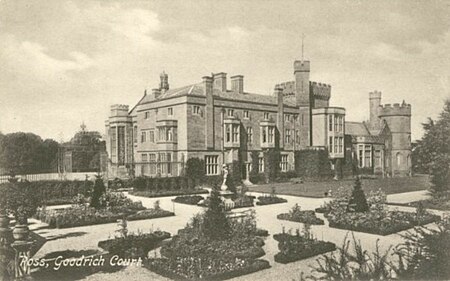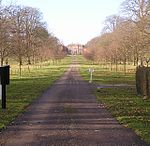Goodrich Court

Goodrich Court, Goodrich, Herefordshire, England was a 19th-century, neo-gothic castle built by the antiquarian Sir Samuel Rush Meyrick in 1828. Designed by the architect Edward Blore, the court is described by Pevsner as a "fantastic and enormous tower-bedecked house." The court's situation, on a hilltop facing Goodrich Castle, so offended the poet William Wordsworth that he wished "to blow away Sir Samuel Meyrick's impertinent structure and all the possessions it contained." Meyrick built the court to house his very significant collection of armour and antiquities, much of which subsequently passed to the British Museum and to the Wallace Collection. In the years following its construction, Meyrick's house and its collections became a notable element of the Wye Tour. Meyrick's son predeceased him and after Meyrick's death, the court passed through a number of hands, housing pupils from Felsted School during the Second World War. When the school left, the building was stripped of its contents, furnishings and fixtures, and completely demolished in 1949–50. Today, apart from a small lodge and the stables, the only significant remainder is the Monmouth Gatehouse, which stands on the Monmouth to Ross-on-Wye Road.
Excerpt from the Wikipedia article Goodrich Court (License: CC BY-SA 3.0, Authors, Images).Goodrich Court
Geographical coordinates (GPS) Address Nearby Places Show on map
Geographical coordinates (GPS)
| Latitude | Longitude |
|---|---|
| N 51.8814 ° | E -2.6314 ° |
Address
HR9 6HR
England, United Kingdom
Open on Google Maps








